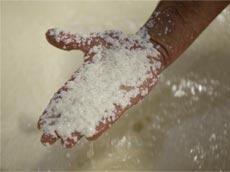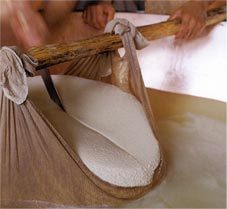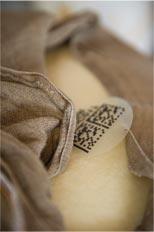How to Make Parmesan Cheese
If you’ve ever wondered how to make Parmesan cheese, also known as Parmigiano Reggiano® cheese, you’re on the right page! Parmesan cheese has been crafted in the same way by skilled artisans for more than 800 years. The traditional method calls for 13 separate steps, followed by patient aging.
Collecting Evening Milk
Parmesan cheese making begins with rich milk from cows fed an all-natural diet of grasses and hay from the approved region of production. As the milk rests overnight in metal trays, the cream rises to the top.
Skimming and Addition of Morning Milk
The cheese maker skims the evening milk, combining it with whole milk from the morning milking.
Whey Starts the Cheese Making
The milk is gently warmed in large cauldrons and some naturally fermented whey from the previous day’s production is stirred in. The whey, a thin but highly nutritious byproduct of Parmesan cheese making, starts the acidification of the milk.
Natural Rennet Goes In
Now the cheese maker adds natural calf’s rennet, which coagulates the milk. Curds form after about 20 minutes.
 Breaking Up the Curds
Breaking Up the Curds
Using an enormous balloon whisk called a spino, the cheese maker whisks the curds-and-whey mixture. Once the curds have been broken into pieces the size of a grain of wheat, this step is complete.
Cooking and “Knitting”
The cheese maker gently cooks the mixture to a specific temperature (131˚ Fahrenheit) The heat is turned off and, over a period of about an hour, the curds sink to the bottom of the cauldron. There they knit together to form a spongy mass.
Cheese Maker Delivers “Twins”
Using a long wooden paddle, the cheese maker lifts the curd mass and, dividing it in half, wraps each in muslin. The newly born cheeses are called “twins” (gemini in Italian) and, truly, they are identical—created from the same batch of milk, under exactly the same conditions.
 Freshly Made Cheeses, Hung to Dry
Freshly Made Cheeses, Hung to Dry
In their muslin wrappings, the cheeses are hung on poles to shed excess liquid. Meanwhile, the whey drains out of the cauldron. Not a drop is wasted! Some of the whey is used in the next day’s cheese making and the remainder feeds local pigs destined to become Prosciutto di Parma.
 Applying the “Birth Certificate”
Applying the “Birth Certificate”
The cheese-making process continues with the transfer of the cheeses to round, straight-sided wooden forms. On top of each cheese, the cheese maker presses a round casein plaque (completely edible) with a data matrix traceability code. This scannable plaque contains a wealth of information, including the dairy of origin. Excess liquid continues to drain from the cheeses. They are turned several times and weighted gently, but are not pressed like other hard grating cheeses.
Parmesan Wheels Get Their Pin Dots
A plastic insert, placed between each wooden mold and the still-soft cheese, imprints the words Parmigiano Reggiano on the perimeter of each wheel. The cheese producer’s code and date of production are also included. These words in pin dots are the retailer’s and consumer’s guarantee of authenticity!
Brining, a Critical Cheese-Making Step
The cheeses are turned into tanks filled with a sea-salt solution, where they stay for about 24 days.
Parmesan Cheese Aging Begins
Now the cheese maker transfers the wheels to curing rooms, where they remain one year. Every 10 days, each wheel is carefully wiped, brushed and turned.
Final Cheese-Making Step: Fire Branding
Through a series of tests, independent inspectors determine whether the cheese meets the high standards of the Consorzio del Formaggio Parmigiano Reggiano.
So that’s the story of how to make Parmesan cheese. Now that you’re familiar with the basic steps, there’s more to learn about the aging and certification processes for Parmigiano Reggiano.